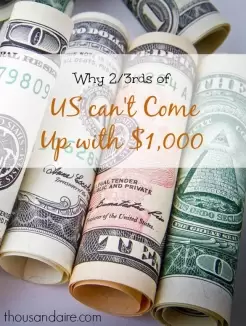 Sometimes life throws you a curveball and you need to come up with some money on short notice. It might be that you need to replace the windshield on your car, you might suddenly need to take a flight to see an ailing parent. Life works better if there is some slack in your finances.
Sometimes life throws you a curveball and you need to come up with some money on short notice. It might be that you need to replace the windshield on your car, you might suddenly need to take a flight to see an ailing parent. Life works better if there is some slack in your finances.
Why do I bring this up? This article came across my desk earlier this week. Fully two-thirds of American’s don’t have $1,000 lying around in case of an emergency. One hopes that the news isn’t as grim as it sounds, and there are a few problems with some of the facts in the article. (Food prices have been dropping like a rock as a share of disposable income). Other than that it paints a depressing picture about the state of most people’s finances, it also explains the popularity of low/no deductible insurance plans and extended warranties.
The Expense of Illiquidity
Many of the people who can’t come up with $1,000 aren’t even poor. 38% of households making over $100,000 can’t come up with the $1,000. These are people who make more than $8,000 per month, and their finances are run so tightly that they can’t set aside 12% of their income for one month to provide some cushion. This is crazy, mostly because it could mean that you end up paying substantially more for everything.
If you can’t afford to replace your cell phone if you break it that means you either need to buy some sort of insurance, borrow money from friends/family, sell assets, or put it on a credit card. If you throw it on the credit card carrying a balance comes with high aprs. If it takes you 2-3 months to come up with the money you’re looking at $60 of finance charges. Cell phone insurance with a $250 deductible typically runs $8-10 per month or about $100 per year. Naturally my advice there is to not carry cell phone insurance and use that $250 to get a used phone, but that’s just me.
This is repeated over and over for every valuable thing a person owns! Extended warranties for laptops, large appliances, and so on. The profit margin on an extended warranty from Best Buy is estimated to be about 50%. That means, on average, that you’re taking a 50% haircut when you fork over warranty money. All of which could be avoided if you just saved a little bit of money.
The Standard Solution
Dave Ramsey, a popular personal finance guru, suggests that you save up $1,000 for an emergency fund, even if you have credit card debt. Leaving $1,000 in a savings/checking account generates a little interest (well, 3% if you use a high-interest checking account), but mainly it provides you with piece of mind.
It’s easy to get used to the constant stress that comes from living on the edge without an emergency fund. You begin not to realize the pressure you feel every day. Every strange hiccough your car gives creates anxiety. Once you save your first thousand dollars it’s like taking off ski boots. The uncomfortable pain you had been living with all day is suddenly gone. It is replaced with the glorious power to write a large check and not have to care.
The Good Solution
Maybe this is the part where you expect me to say, keep an emergency fund of 10 months expenses sitting around. After all, we haven’t discussed the big emergency. What if I lose my job? Having a giant pile of cash sure helps, but watching a supply of cash melt away while you’re on a job hunt is a recipe for its own sort of anxiety. Yes, this is better than having nothing, but instead I propose that you rethink your budget entirely.
The lower your expenses are relative to your income the better you’ll be able to handle what life has to throw your way. This takes discipline. It’s practically an assumption in the US that your expenses = your income. This is terrible. Instead you need to make sure that your fixed expenses, the bills you have to pay, are a small percentage of your income. They should be less than your income from your main job.
This is easiest if you’re married. The person with the smaller income should be able to cover the mortgage/rent, health insurance, food, utilities, auto insurance, and any finance charges that have to be paid month to month. This means that if one of you loses your job you can search for a new one indefinitely simply by tightening the belt on your wants.
If you’re single this requires a bit more work. Typically when you lose your job you’ll get one last paycheck which you’ll have to stretch for, say 6 months. If you have no income from a side business, then you’ll need to make sure that your fixed expenses are no more than 8% of your income. Considering that you ought to be spending no more than 50% of your income this shouldn’t be impossible.
The thing you have most control over here is your costs. If you make $36,000 per year you should spend $480 on rent, food, and so on. Naturally this gets significantly easier if you make even $200 per month from a side business, that income you can directly add to your fixed expenses. This assumes that if you lose your job your side business will stay intact.
You might be inclined to ask, “Adam, if I’m not spending such a large percentage of my main income why aren’t you including that as money that could be used in the event of job loss?” Well, that money should be shoved into tax advantaged retirement accounts. Any leftover goes into brokerage accounts. In just a few years income from your investments will start to become substantial enough that you could survive on it if you had to.
Your goal this month? Save $1,000. Apparently, that’s enough to put you in the top third of the population.
Adam Woods is a physicist. His research interests include building software to run and build geomagnetic models. Adam got interested in personal finance in the great recession when it became obvious an interest was necessary.
After harassing his friends and family (and a short intervention) he took to the web where he blogs about finance, investment, politics, and economics.
Adam is currently located in Boulder, Colorado where he can generally be found hiking, biking, or running a D&D campaign. He can also be contacted at adamwoods137@gmail.com.



You presented some perfectly good points and made me realize, why in the heck am I paying insurance on my phone? I have more than $1,000 set aside and I could actually replace my phone if needed. Needless to say, I’m heading over now and cancel that so I can save my ten bucks!
I think “make sure that your fixed expenses are no more than 8% of your income” is an incredibly low number and a nice goal, but not all that realistic in many situations.
That 8% figure, in my view, is really an argument that for safety’s sake one really needs multiple sources of income. Who has fixed expenses of 8%? If you do, more power to you, but I find it easier to have a backup income in case my primary income becomes impaired.
I agree that it’s terrifying so few people have even $1,000 put aside. It can be hard to build a buffer in many circumstances, but essential.
Too many people see low interest rates and conclude that it isn’t worth keeping any cash because it is “just going to lose money due to inflation”. The thing is, most people don’t save that money anywhere else then. Instead, they use it to support their over stretched lifestyle. Many people look for an excuse to spend money and don’t have to look too hard to find one. The best we can do is keep trying to make one person at a time realize that they can live their life differently!
Such a thought provoking post. But so true on so many levels – why pay insurance on your phone when you can smply have a phone that you can afford to replace if it gets stolen or damaged. I wish I’d thought along those lines before I’d extended my two year contract with a fancy brand new cell phone with my current service provider last year. Although I never took out insurance on my phone the two year contract I now continue to be saddled with is just not worth it.